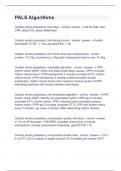PALS Algorithms
Cardiac arrest (pulseless), first steps - correct answer ✔call for help; start
CPR; attach O2; attach defibrillator
Cardiac arrest (pulseless), first decision point - correct answer ✔rhythm
shockable? VT/VF -> Yes; asystole/PEA -> No
Cardiac arrest (pulseless), first shock dose (and subsequent) - correct
answer ✔2 J/kg, increase by 2 J/kg each subsequent dose to max 10 J/kg
Cardiac arrest (pulseless), shockable algorithm - correct answer ✔CPR;
rhythm check ASAP, shock and treat known/likely causes; CPR 2 minutes;
rhythm check+shock; CPR+epinephrine 2 minutes (consider ETT); rhythm
check+shock; CPR+amiodarone 2 minutes (treat reversible causes
empirically); rhythm check+shock; then repeat 2 minutes cycles of CPR+
alternating epi/amio with shocks between med doses
Cardiac arrest (pulseless), non-shockable algorithm - correct answer ✔CPR;
rhythm check ASAP, identify non-shockable rhythm; CPR+epi 2 minutes
(consider ETT); rhythm check; CPR 2 minutes (treat reversible causes);
rhythm check; CPR+epi 2 minutes (consider ETT); CPR with rhythm check
every 2 minutes, epi every 4 minutes (after alternating rhythm checks)
Cardiac arrest (pulseless), compression quality indicators - correct answer
✔>1/3 of AP diameter, >100 BPM, complete chest recoil, minimize
interruptions, change compressors frequently; goal ETCO2 >10
Cardiac arrest (pulseless), compression:breath ratio - correct answer ✔15:2
if no ETT (30:2 in adults or single rescuer); 8-10 breaths per minute if ETT
, Cardiac arrest (pulseless), drug doses - correct answer ✔epinephrine 0.01
mg/kg IV bolus (0.1mL/kg 1:10,000); epinephrine 0.1 mg/kg Et bolus
(0.1mL/kg 1:1000); amiodarone 5 mg/kg IV bolus, may give second dose
Reversible causes of arrest - correct answer ✔Hypovolemia, Hypoxia,
Hydrogen ions, Hyper/hypokalemia, Hypoglycemia, Hypothermia, Tension
pneumothorax, Tamponade cardiac, Toxins, Thrombosis pulmonary/coronary,
Trauma
Epinephrine, cardiac arrest dose - correct answer ✔0.01 mg/kg IV (0.1
mL/kg 1:10,000); 0.1 mg/kg ET (0.1 mL/kg 1:1000); repeat every 3-5 minutes
Amiodarone, cardiac arrest (VF/VT) dose - correct answer ✔5 mg/kg IV
bolus, maximum 300 mg; may give second dose (up to 15 mg/kg/d or 2.2
g/d?)
Bradycardia with a pulse and poor perfusion, first steps - correct answer
✔ABCs; maintain airway, assist if needed; O2; monitor HR, SpO2, BP; IV/IO
access; ECG if available
Bradycardia with a pulse and poor perfusion, first decision point - correct
answer ✔cardiopulmonary compromise continues despite correcting
airway/breathing issues? No: support ABCs, address cause; Yes: evaluate
HR
Bradycardia with a pulse and poor perfusion, second decision point - correct
answer ✔cardiopulmonary compromise continues despite correcting
airway/breathing issues, now evaluate HR: if <60, start CPR, give
epinephrine, atropine, consider pacing, treat underlying causes




